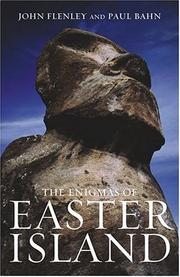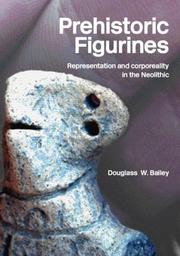| Listing 1 - 10 of 38 | << page >> |
Sort by
|
Book
ISBN: 2903721343 Year: 1988 Publisher: Paris : Penta-di Casinca (Haute-Corse) : [Malakof] : Lettres Vives ; Associu Paleocorsu ; diff. Distique,
Abstract | Keywords | Export | Availability | Bookmark
 Loading...
Loading...Choose an application
- Reference Manager
- EndNote
- RefWorks (Direct export to RefWorks)
Paleolithic period --- Sculpture, Prehistoric --- Tools, Prehistoric
Book
Year: 1976 Publisher: Toulouse : Éditions des Hespérides,
Abstract | Keywords | Export | Availability | Bookmark
 Loading...
Loading...Choose an application
- Reference Manager
- EndNote
- RefWorks (Direct export to RefWorks)
Neolithic period --- Menhirs --- Sculpture, Prehistoric --- Menhirs --- Sculpture, Prehistoric --- France --- Europe --- Antiquities. --- Antiquities.
Book
ISBN: 1880636115 9781880636114 Year: 1997 Publisher: Los Osos, CA Bearsville Press and Cloud Mountain Press
Abstract | Keywords | Export | Availability | Bookmark
 Loading...
Loading...Choose an application
- Reference Manager
- EndNote
- RefWorks (Direct export to RefWorks)
Sculpture, Prehistoric --- Sculpture, Prehistoric --- Easter Island --- Easter Island --- Antiquities. --- Antiquities --- Collection and preservation.
Book
ISBN: 1789250226 178925020X 9781789250206 9781789250190 1789250196 Year: 2019 Publisher: Oxford : Oxbow Books,
Abstract | Keywords | Export | Availability | Bookmark
 Loading...
Loading...Choose an application
- Reference Manager
- EndNote
- RefWorks (Direct export to RefWorks)
"The Chalcolithic period in Cyprus has been known since Porphyrios Dikaios' excavations at Erimi in the 1930s and through the appearance in the antiquities market of illicitly acquired anthropomorphic cruciform figures, often manufactured from picrolite, a soft blue-green stone. The excavations of the settlement and cemetery at Souskiou Laona reported on in this volume paint a very different picture of life on the island during the late 4th and early 3rd millennia BC. Burial practices at other known sites are generally single inhumations in intramural pit graves, only rarely equipped with artefacts. At Souskiou, multiple inhumations were interred in deep rock-cut tombs clustered in extra-mural cemeteries. Although the sites were also subjected to extensive looting, excavations have revealed complex multi-stage burial practices with arrangements of disarticulated and articulated burials accompanied by a rich variety of grave goods. Chief among these are a multitude of cruciform figurines and pendants. This unusual treatment of the dead, which has not been recorded elsewhere in Cyprus, shifts the focus from the individual to the communal, and provides evidence for significant changes involving kinship group links to common ancestors. Excavations at the Laona settlement have furnished evidence suggesting that it functioned as a specialised centre for the procurement and manufacture of picrolite during its early phase. The subsequent decline of picrolite production and the earliest known occurrence of new types of ornaments, such as faience beads and copper spiral pendants, attest to important changes involving the transformation of personal and social identities during the first centuries of the 3rd millennium BC, a topic that forms a central theme of this final report on the site"--
Figurines, Prehistoric --- Prehistoric figurines --- Statuettes, Prehistoric --- Sculpture, Prehistoric
Book
Abstract | Keywords | Export | Availability | Bookmark
 Loading...
Loading...Choose an application
- Reference Manager
- EndNote
- RefWorks (Direct export to RefWorks)
The monumental statues of Easter Island, gazing out in their imposing rows over the island's barren landscape, have been a great mystery ever since the island was first discovered by Europeans. How could the ancient people who inhabited this tiny speck of land, the most remote in the vast expanse of the Pacific, have built such monumental works, and moved them from the quarry where they were carved to the coast? And if the island once boasted a culture sophisticated enough to have produced such marvelous edifices, what happened to that culture? The prevailing accounts of the island's history tell a story of self-inflicted devastation: a glaring case of eco-suicide. But when Terry Hunt and Carl Lipo began carrying out archaeological studies on the island in 2001, they uncovered a very different truth: they show that the Easter Islanders were remarkably inventive environmental stewards, rich with lessons for confronting the daunting environmental challenges of our own time.--From publisher description.
Polynesians --- Prehistoric peoples --- Sculpture, Prehistoric --- Antiquities --- Easter Island --- Antiquities.

ISBN: 0192803409 Year: 2003 Publisher: Oxford Oxford university press
Abstract | Keywords | Export | Availability | Bookmark
 Loading...
Loading...Choose an application
- Reference Manager
- EndNote
- RefWorks (Direct export to RefWorks)
Prehistoric peoples --- Sculpture, Prehistoric --- Easter Island --- Easter Island --- Antiquities. --- History.
Book
ISBN: 8672690737 Year: 2006 Publisher: Belgrade National museum
Abstract | Keywords | Export | Availability | Bookmark
 Loading...
Loading...Choose an application
- Reference Manager
- EndNote
- RefWorks (Direct export to RefWorks)
Archaeoastronomy --- Neolithic period --- Sculpture, Prehistoric --- Lepenski Vir Site (Serbia)
Book
Year: 1976 Publisher: Toulouse : Editions des Hespérides,
Abstract | Keywords | Export | Availability | Bookmark
 Loading...
Loading...Choose an application
- Reference Manager
- EndNote
- RefWorks (Direct export to RefWorks)
Neolithic period --- Menhirs --- Sculpture, Prehistoric --- Menhirs --- Sculpture, Prehistoric --- Néolithique --- Menhirs --- Sculpture préhistorique --- France --- Europe --- France --- Europe --- Antiquities --- Antiquities --- Antiquités --- Antiquités

ISBN: 1134323298 1134323301 1280243880 9786610243884 0203392450 9780203392454 9780415331517 041533151X 9780415331524 0415331528 6610243883 041533151X 0415331528 9781134323302 9781134323258 1134323255 9781134323296 Year: 2005 Publisher: London ; New York : Routledge,
Abstract | Keywords | Export | Availability | Bookmark
 Loading...
Loading...Choose an application
- Reference Manager
- EndNote
- RefWorks (Direct export to RefWorks)
Fully illustrated, Prehistoric Figurines brings a radical new approach to one of the most exciting, but poorly understood artefacts from our prehistoric past. Studying the interpretation of prehistoric figurines from Neolithic southeast Europe, Bailey introduces recent developments from the fields of visual culture studies and cultural anthropology, and investigates the ways in which representations of human bodies were used by the pre-historic people to understand their own identities, to negotiate relationships and to make subtle political points.Bailey examines four critic
Figurines, Prehistoric --- Prehistoric figurines --- Statuettes, Prehistoric --- Sculpture, Prehistoric --- Balkan Peninsula --- Antiquities.
Book
Year: 1977 Volume: 4 Publisher: Lyon : Maison de l'Orient,
Abstract | Keywords | Export | Availability | Bookmark
 Loading...
Loading...Choose an application
- Reference Manager
- EndNote
- RefWorks (Direct export to RefWorks)
Idols and images --- Sculpture, Prehistoric --- Idoles et images --- Cyprus --- Chypre --- Antiquities --- Antiquités
| Listing 1 - 10 of 38 | << page >> |
Sort by
|

 Search
Search Feedback
Feedback About UniCat
About UniCat  Help
Help News
News